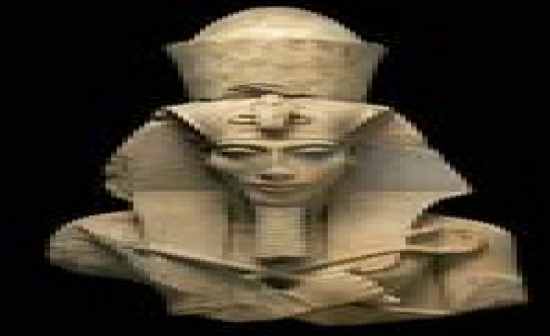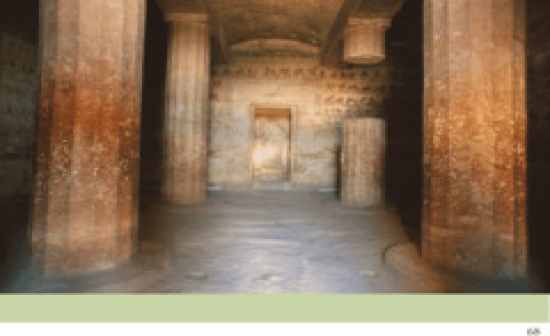Cards In This Set
| Front | Back |
 Akhenaten |
Period: New Kingdom
Dates:1353-1335 BCE Medium: Sandstone Located: Found in Akhenaten's temple at Karnak (Karnak, Egypt) Dynasty: 18th Facts: - Effeminate body, weak limbs, sagging belly, curving contours - Pharaoh is depicted with a distorted physique which is not present elsewhere in the artwork of Ancient Egypt. - Three-dimensional statue - Has protruding stomach, thin arms, and exaggerated facial features (long nose, hanging chin, and thick lips). - Feminine curves, heavy thighs and belly, half-closed eyes, full lips and a long face and neck characterized representations of the king. - The excavation, begun by Henri Chevrier in 1925, uncovered 25 fragments of the broken colossi in Eastern Karnak in Thebes, which are now located in the Cairo Museum in Egypt. |
|
Funerary Mask of Tutankhamun |
Period: New Kingdom
Dates: 1323 BCE Medium: Gold inlaid with glass and semiprecious stones Located: Egyptian Museum, Cairo Dynasty: 18th Facts: - It's size is height 21 1/4 and 54.4 cm - It weighs 24 pounds |
|
Hatshepsut Offering Jars |
Period:
Dates: 1473-1458 BCE Medium: Red granite Located: Deir el-Bahri, Egypt Dynasty: 18th Facts: |
|
Judgement of Hunefer Before Osiris |
Period: Amarna
Dates: 1285 BC Medium: Painted papyrus Located: Thebes, Egypt Dynasty: 19th Facts: - Example of one of the many fine vignettes (illustrations) from the Book of the Dead of Hunefer. - The scene reads from left to right. - From the left, Anubis brings Hunefer into the judgement area. Anubis is also shown supervizing the judgement scales. hunefer's heart, represented as a pot, is being weighted against a feather, the symbol of Maat, the established order of things, in this context meaning 'what is right'. The heart hold the person's character throughout life. If the heart did not balance with the feather, then the dead person was condemned to non-existence and consumption of the beast shown which is part-crocodile, part-lion, and part-hippopotamus. - To the right, a papyrus devoted to ensuring Hunefer's continued existence in the Afterlife is not likely depict this outcome. Brought into the presence of Osiris by his son Horus, having become 'true of voice' or 'justified'. - Osiris is shown seared under a canopy, with his sisters Isis and Nephthys. - At the top, Hunefer is shown adoring a row of deities who supervise the judgement. |
|
Khafre Enthroned |
Period: Old Kingdom
Dates: 2520-2494 BCE Medium: Diorite Located: Giza, Egypt/ Valley Temple of Khafre Dynasty: 4th Facts: - It's size is height 5'6 1/8 (1.68 m) - Holding place for Ka - Horus extends protection - Rigid limbs close to body |
|
Nefertiti |
Period: New Kingdom
Dates: 1353-1335 BCE Medium: Painted limestone Located: Amarna, Egypt Dynasty: 18th Facts: - Artist is Thutmose |
|
North Palace of Djoser |
Period: Old Kingdom
Dates: 2630-2611 BCE Medium: Located: Saqqura, Egypt Dynasty: 3rd Facts: - Columns in capitols (heads) that take form of papyrus blossoms and columns shafts resemble papyrus stalks. They're engaged (attached) to walls. |
|
Palette of Narmer |
Period: Pre-Dynastic
Dates: 3000-2920 BCE Medium: Green schist/ Slate Located: Hierakonpolis (archaeological site in Egypt) Dynasty: Facts: - It's size is height 25" and 64 cm - Palette of King Narmer - Bas relief -Each side divided into register - King wears hat of upper Egypt - Horus protects king - Circular depression held eye makeup - Unification of Egypt (Lower and Upper Egypt) - Papyrus plant of lower Egypt - Intertwined necks symbolize unification - Decapitated enemies |
|
Rock-Cut Tombs (Beni Hasan) |
Period: Middle Kingdom
Dates: 1950-1900 BCE Medium: Stone Located: Beni Hasan, Egypt Dynasty: 12th Facts: - Burial places hollowed out of the faces of cliffs - Hallowed out cliffs - Shallow columnar porch - Fluted stone columns inside |
|
Seated Scribe |
Period: Old Kingdom
Dates: 2500 BCE Medium: Painted limestone Located: Saqqura, Egypt Dynasty: 5th Facts: - At the tomb of Kai - Shows high position in society because writing and reading are rare (holding tablet). - Not idealized--- realistic (not ideal body) - Intentive expression |
|
Menkaure and Khamerernebty |
Period: Old Kingdom
Dates: 2490-2472 BCE Medium: Graywacke with traces of red and black paint Located: Giza, Egypt Dynasty: 4th Facts: - It's size is height of 54 1/2 (142.3 cm) - Arms around waist symbolizes marital status - Left legs advanced - Rigid features - Standardized canon |
|
Temple of Ramses |
Period: New Kingdom
Dates: 1290-1224 BCE Medium: Sandstone Located: Abu Simbel, Egypt Dynasty: 19th Facts: - Moved in 1968 to avoid flooding - 4 statues on facade - More statue columns inside |
 Tomb of Amenemhet |
Period: Middle Kingdom
Dates: 1950-1900 BCE Medium: Stone Located: Beni Hasan, Egypt Dynasty: 12th Facts: - More elaborate than earlier tombs - The architecture of Amenemhet's tomb differs from the earlier style by having a courtyard and a portico with two columns before the entrance to the tomb-chapel. - The tomb chapel is large and rectangular and contains four wide polygonal pillars and two burial shafts. - It has an elaborately decorated ceiling which is divided into 3 naves, each with a vaulted roof. - The wall-paintings contain themes similar to earlier tombs, with agriculture and industries, hunting in the desert, military activities and funeral rites with offering-bringers. - Amenemhet also had his wife Hemet buried their |
|
Victory Statue of Naram-Sin |
Period: Akkad
Dates: 2254-2218 BCE Medium: Pink sandstone Located: Susa, Iran Dynasty: 18th Facts: - This monument depicts the Akkadian victory over the Lullubi Mountain people. IN the 12th century BCE, 1,000 years after it was originally made, the Elamite king Shutruk-Nahhunte attacked Babylon and, according to his later inscription, the stele was taken to Susa in what is now Iran. - A stele is a vertical stone monument or marker often inscribed with text or relief carving. |



